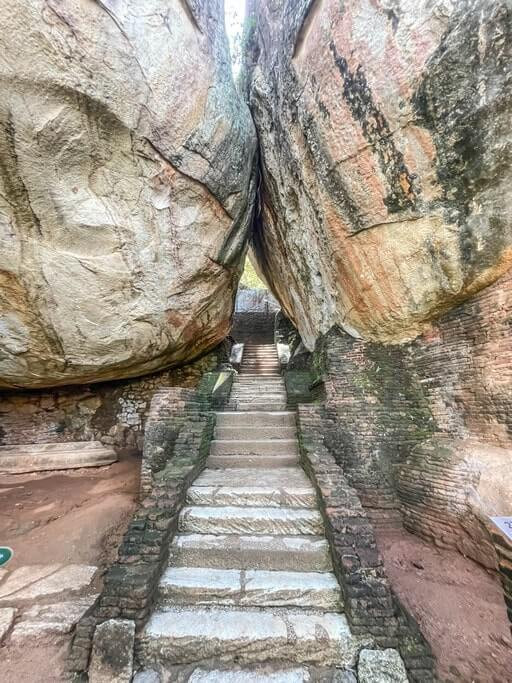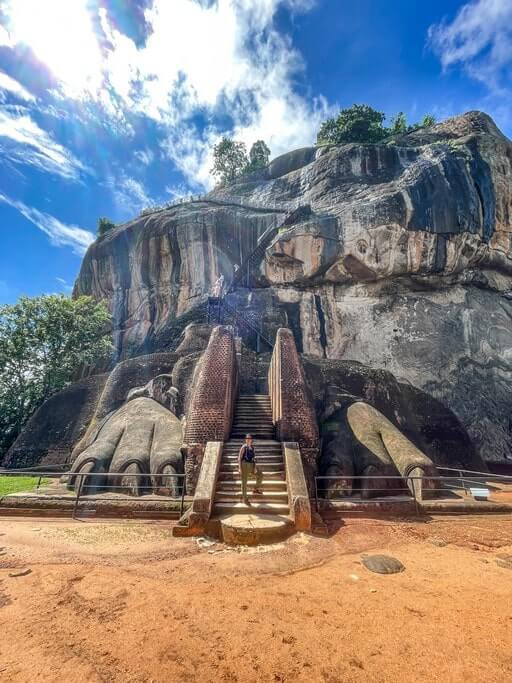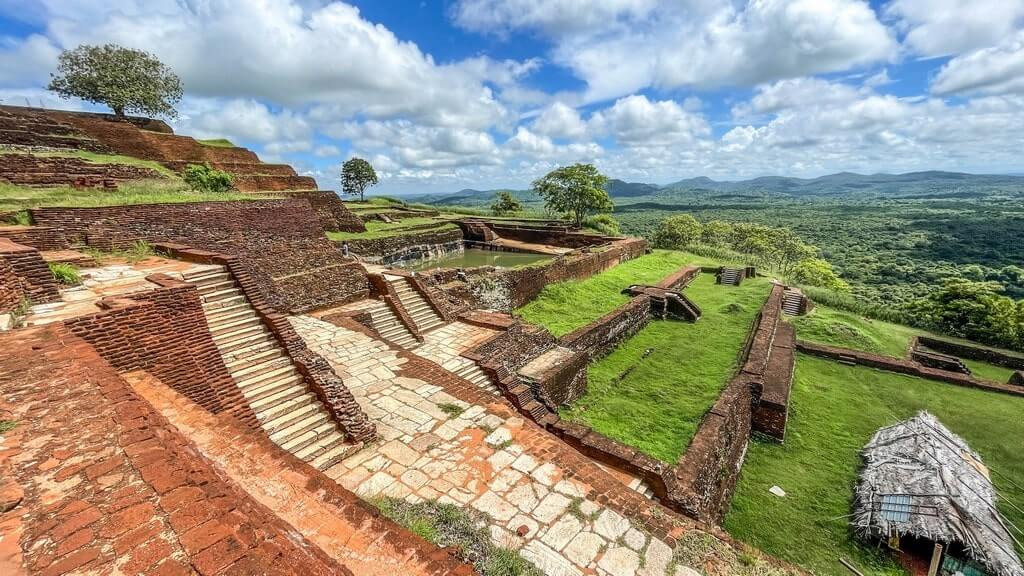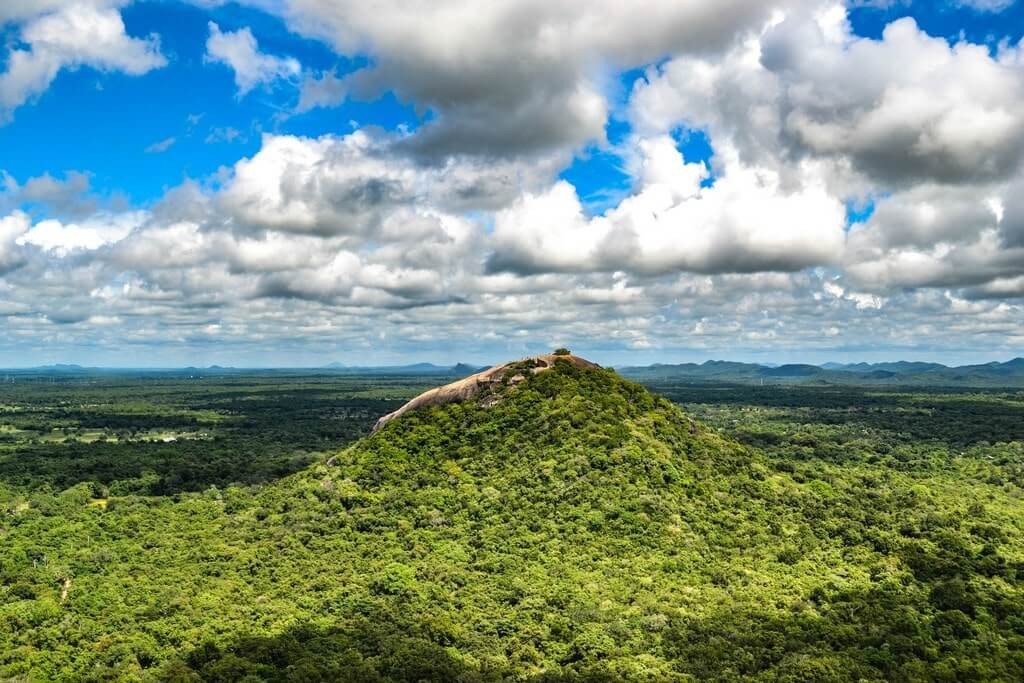Curious about the Sigiriya Rock climb and wondering How Many Steps Up Sigiriya Rock you’ll need to conquer? This iconic Sri Lankan landmark, a stunning blend of history and natural beauty, attracts adventurers worldwide. At rockscapes.net, we’re passionate about sharing the allure of unique rock formations and landscapes. Discover everything you need to know about the climb, its challenges, and how to prepare for this unforgettable journey, ensuring a safe and fulfilling experience. Explore the majestic Sigiriya Rock with confidence, uncover ancient secrets, and embrace breathtaking panoramic views.
1. Unveiling Sigiriya Rock: A Historical and Geological Marvel
Sigiriya, also known as Lion Rock, isn’t just a climb; it’s a journey through time. Understanding its historical significance and geological formation enhances the appreciation of this magnificent site.
1.1. A Glimpse into Sigiriya’s Rich History
Sigiriya served as a royal citadel for King Kasyapa I in the 5th century AD. He transformed the massive rock into a fortress and palace, complete with elaborate gardens, moats, and fortifications. After Kasyapa’s death, the site became a Buddhist monastery, preserving its historical and cultural importance. The intricate frescoes, mirror wall, and impressive architecture showcase the advanced engineering and artistic skills of the ancient Sri Lankans.
1.2. The Geology of Sigiriya Rock
Sigiriya Rock is a magmatic plug, the solidified core of an extinct volcano. Over millennia, erosion sculpted the surrounding landscape, leaving the towering rock formation we see today. The rock’s reddish hue comes from the iron oxides present in the rock composition. This geological marvel provides a dramatic backdrop to the historical structures built upon it, creating a unique blend of nature and human ingenuity.
2. How Many Steps Does the Sigiriya Rock Climb Involve?
So, how many steps are there up Sigiriya Rock? This is the question on many adventurers’ minds as they plan their climb.
2.1. The Total Number of Steps
The Sigiriya Rock climb involves approximately 1200 steps. While the exact number may vary slightly depending on different counts, this figure is widely accepted. These steps are not evenly distributed, with varying inclines and structures along the way.
2.2. Breakdown of the Climb
The climb can be broken down into sections:
- Base to the Water Gardens: Initial set of steps leading to the beautiful water gardens.
- Water Gardens to the Boulder Gardens: Gradual ascent through landscaped gardens.
- Boulder Gardens to the Lion’s Paws: A steeper climb through natural rock formations.
- Lion’s Paws to the Summit: The most challenging section, with steep steps and exposed conditions.
2.3. Variation in Step Construction
The steps themselves vary in construction. Some are ancient stone steps, while others are more modern concrete or metal structures. The varying conditions require climbers to be mindful of their footing and pace.
3. Preparing for the Sigiriya Rock Climb: Fitness, Gear, and Timing
Climbing Sigiriya Rock is an achievable feat for most, but preparation is key.
3.1. Assessing Your Fitness Level
A moderate level of fitness is recommended for the climb. If you’re generally active and can handle walking uphill for an extended period, you should be fine. If you have any health concerns, consult your doctor before attempting the climb.
3.2. Essential Gear for the Climb
- Comfortable Shoes: Wear sturdy shoes with good traction. Hiking shoes or athletic shoes are ideal.
- Lightweight Clothing: Opt for breathable fabrics that wick away moisture.
- Sun Protection: A hat, sunglasses, and sunscreen are essential to protect yourself from the sun.
- Water: Carry at least 1-2 liters of water to stay hydrated.
- Snacks: Energy bars or fruit can provide a quick boost.
- Backpack: A small backpack is useful for carrying your essentials.
3.3. Best Time to Climb Sigiriya
The best time to climb Sigiriya is early in the morning (around 7:00 AM) or late in the afternoon (after 3:00 PM) to avoid the midday heat. The archaeological site opens at 7 AM daily, allowing you to beat the crowds and enjoy cooler temperatures.
4. Navigating the Sigiriya Steps: What to Expect Along the Way
The journey up Sigiriya Rock is as rewarding as reaching the summit.
4.1. Water Gardens
The water gardens are a series of interconnected pools, fountains, and terraces showcasing ancient hydraulic engineering. These gardens provide a gentle start to the climb and a glimpse into the sophistication of the ancient city.
4.2. Boulder Gardens
The boulder gardens feature natural rock formations interspersed with stairways and pathways. These gardens offer shaded rest stops and unique photo opportunities.
 Boulder gardens with natural rock formations on the way to Sigiriya Rock.
Boulder gardens with natural rock formations on the way to Sigiriya Rock.
4.3. Fresco Gallery
Located midway up the rock, the Fresco Gallery houses vibrant paintings of ancient Sri Lankan women. These well-preserved frescoes offer a glimpse into the artistic heritage of Sigiriya.
4.4. Mirror Wall
The Mirror Wall is a polished wall once covered in graffiti left by visitors centuries ago. The wall reflects sunlight and provides panoramic views of the surrounding landscape.
4.5. Lion’s Paws
The Lion’s Paws are the remnants of a massive lion sculpture that once guarded the entrance to the summit. These imposing paws mark the start of the final, steepest ascent.
 Author at the Lion's Paw on the Sigiriya rock climb.
Author at the Lion's Paw on the Sigiriya rock climb.
4.6. The Summit
The summit of Sigiriya Rock offers breathtaking panoramic views of the surrounding plains, forests, and mountains. The ruins of the ancient palace provide a tangible connection to the past.
 Remains of the royal palace at the top of Sigiriya Rock
Remains of the royal palace at the top of Sigiriya Rock
5. Tips for a Successful Sigiriya Rock Climb
Here are some practical tips to ensure a safe and enjoyable climb.
5.1. Pace Yourself
Don’t rush the climb. Take frequent breaks to catch your breath and enjoy the scenery.
5.2. Stay Hydrated
Drink water regularly, especially during the hotter parts of the day.
5.3. Be Mindful of Your Surroundings
Watch your step and be aware of other climbers. The steps can be uneven and slippery in places.
5.4. Consider a Guide
A local guide can provide valuable insights into the history and significance of Sigiriya. They can also help you navigate the climb and point out interesting features.
5.5. Respect the Site
Sigiriya is a UNESCO World Heritage Site. Be respectful of the ancient structures and avoid littering.
6. Alternative Perspectives: Is Sigiriya Rock Climb Right for You?
While the Sigiriya Rock climb is a popular attraction, it’s essential to consider if it aligns with your personal preferences and abilities.
6.1. Physical Limitations
If you have significant mobility issues, knee problems, or respiratory conditions, the climb may be too strenuous. Consider consulting your doctor for advice.
6.2. Fear of Heights
The climb involves steep ascents and exposed areas. If you have a fear of heights, you may find some sections challenging.
6.3. Alternative Options
If you’re unable or unwilling to climb Sigiriya Rock, there are other ways to experience the site. You can explore the water gardens and museum at the base of the rock or enjoy panoramic views from nearby Pidurangala Rock.
7. Pidurangala Rock: A Compelling Alternative
Speaking of alternatives, Pidurangala Rock offers stunning views of Sigiriya and is a worthy experience in its own right.
7.1. About Pidurangala Rock
Located a short distance from Sigiriya, Pidurangala Rock provides an excellent vantage point for viewing Sigiriya. The climb to Pidurangala is shorter and less strenuous, making it a suitable option for those who prefer a less challenging hike.
7.2. The Pidurangala Climb
The climb to Pidurangala involves a combination of steps and rock scrambling. The final ascent requires navigating between and under large boulders, adding an element of adventure.
7.3. Pidurangala Views
From the summit of Pidurangala, you can enjoy panoramic views of Sigiriya Rock and the surrounding landscape. The view of Sigiriya rising majestically from the plains is particularly impressive.
 Scenic view of Pidurangala Rock from Sigiriya
Scenic view of Pidurangala Rock from Sigiriya
8. Incorporating Rockscapes.net into Your Landscape Aspirations
While Sigiriya Rock is a natural formation, it can inspire your own landscape designs.
8.1. Drawing Inspiration from Sigiriya’s Gardens
The water gardens of Sigiriya can inspire the design of water features in your own garden. Consider incorporating ponds, fountains, and terraced landscaping to create a tranquil and visually appealing space.
8.2. Integrating Natural Stone Elements
Use natural stone elements to create pathways, retaining walls, and rock gardens. Choose stones that complement your local landscape and create a sense of harmony with nature.
8.3. Rock Selection and Placement
At rockscapes.net, we offer a wide variety of natural stones that can enhance your landscape design. Our experts can help you select the right types of stones and provide guidance on placement and installation.
9. Types of Rocks Commonly Used in Landscaping in the USA
Selecting the right rocks for your landscape project depends on your design aesthetic, budget, and regional availability. Here are some popular choices in the USA:
| Rock Type | Description | Common Uses |
|---|---|---|
| River Rock | Smooth, rounded stones typically found near rivers and streams. | Garden beds, pathways, drainage solutions. |
| Flagstone | Flat, sedimentary rock ideal for creating patios and walkways. | Patios, walkways, stepping stones. |
| Boulders | Large, natural rocks that add visual interest and create focal points. | Accents, retaining walls, natural seating. |
| Lava Rock | Porous, volcanic rock that retains moisture and provides excellent drainage. | Mulch, rock gardens, fire pits. |
| Crushed Stone | Aggregate material used for pathways, driveways, and drainage. | Driveways, pathways, base material. |
| Granite | Durable and weather-resistant igneous rock. | Countertops, paving, monuments. |
10. Modern Trends in Rock Landscaping in the USA
Stay ahead of the curve with these modern trends in rock landscaping:
10.1. Xeriscaping
Xeriscaping is a landscaping technique that minimizes water usage by utilizing drought-tolerant plants and rocks. This approach is particularly popular in arid regions.
10.2. Rock Gardens
Rock gardens showcase a variety of rocks and alpine plants. These gardens create a naturalistic and low-maintenance landscape.
10.3. Gabion Walls
Gabion walls are structures made from wire cages filled with rocks. These walls provide erosion control, create retaining walls, and add a rustic aesthetic.
10.4. Water Features
Incorporating rocks into water features, such as waterfalls and ponds, creates a natural and soothing environment.
11. E-E-A-T and YMYL Considerations for Rock Landscaping
When providing information about rock landscaping, it’s crucial to adhere to E-E-A-T (Expertise, Experience, Authoritativeness, and Trustworthiness) and YMYL (Your Money or Your Life) principles.
11.1. Expertise
Demonstrate expertise by providing accurate and well-researched information about different types of rocks, their properties, and their uses in landscaping.
11.2. Experience
Share real-world examples of rock landscaping projects and provide practical tips based on your own experience or the experience of other professionals.
11.3. Authoritativeness
Cite reputable sources, such as geological surveys, landscape architecture publications, and university research, to support your claims.
11.4. Trustworthiness
Be transparent about your credentials and affiliations. Provide clear contact information and disclaimers when necessary.
11.5. YMYL Considerations
Rock landscaping projects can involve safety considerations, such as proper installation techniques and structural stability. Provide accurate and reliable information to help readers make informed decisions and avoid potential hazards.
12. Rockscapes.Net: Your Partner in Creating Stunning Landscapes
At rockscapes.net, we understand the transformative power of rocks in creating beautiful and functional landscapes.
12.1. Inspiration and Ideas
Explore our extensive gallery of rock landscaping projects for inspiration and ideas.
12.2. Expert Advice
Our team of experienced landscape designers and geologists can provide expert advice on rock selection, placement, and installation.
12.3. Quality Materials
We source high-quality natural stones from reputable suppliers to ensure the beauty and durability of your landscape.
12.4. DIY Guides
Access our collection of DIY guides to learn how to create your own rock gardens, pathways, and water features.
13. Answering Your Burning Questions About Sigiriya Rock
Still curious? Let’s tackle some frequently asked questions about the Sigiriya Rock climb.
13.1. Is the Sigiriya Rock Climb Difficult?
The difficulty of the Sigiriya Rock climb depends on your fitness level. Most people with moderate fitness can complete the climb without significant difficulty. The final section from the Lion’s Paws to the summit is the most challenging.
13.2. How Long Does It Take to Climb Sigiriya Rock?
The climb typically takes between 1 to 3 hours, depending on your pace and how much time you spend at the various attractions along the way.
13.3. What Should I Wear for the Sigiriya Rock Climb?
Wear comfortable, lightweight clothing and sturdy shoes with good traction. A hat, sunglasses, and sunscreen are also essential.
13.4. Are There Restrooms on the Sigiriya Rock Climb?
Restrooms are available at the base of the rock but not along the climb. Plan accordingly.
13.5. Can I Bring Food and Drinks on the Sigiriya Rock Climb?
Yes, you can bring food and drinks, but be sure to dispose of your trash properly.
13.6. Are There Monkeys on Sigiriya Rock?
Yes, monkeys inhabit Sigiriya Rock. Be cautious and avoid feeding them.
13.7. Is It Safe to Climb Sigiriya Rock?
The climb is generally safe, but watch your step and be mindful of other climbers.
13.8. Are There Age Restrictions for Climbing Sigiriya Rock?
There are no official age restrictions, but parents should assess their children’s fitness levels before attempting the climb.
13.9. Is Sigiriya Rock Wheelchair Accessible?
Sigiriya Rock is not wheelchair accessible due to the nature of the terrain and the presence of numerous steps.
13.10. What Is the Significance of the Frescoes at Sigiriya Rock?
The frescoes at Sigiriya Rock are believed to depict celestial nymphs or royal concubines. They provide valuable insights into the artistic styles and cultural practices of ancient Sri Lanka.
14. Call to Action
Ready to embark on your own rock landscaping adventure? Visit rockscapes.net today to explore our extensive collection of natural stones, discover inspiring design ideas, and receive expert advice from our team of landscape professionals. Whether you’re creating a serene rock garden, a stunning water feature, or a functional retaining wall, rockscapes.net is your trusted partner in bringing your vision to life. Let us help you transform your outdoor space into a breathtaking oasis of natural beauty.
Address: 1151 S Forest Ave, Tempe, AZ 85281, United States
Phone: +1 (480) 965-9011
Website: rockscapes.net